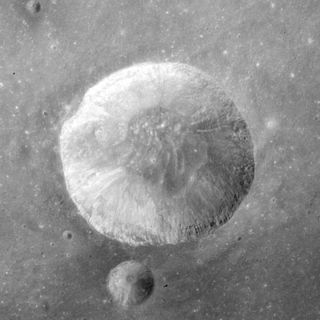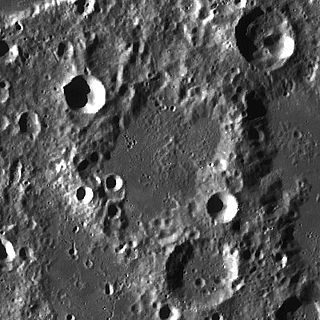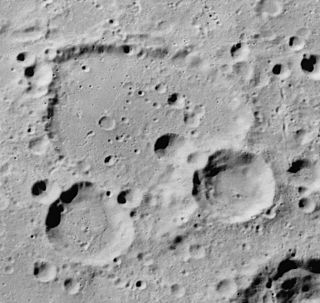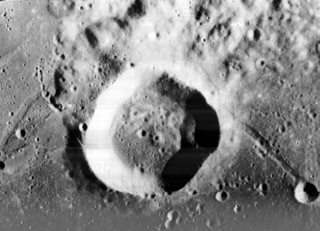
Bianchini is a lunar impact crater that lies along the northern Jura Mountains that ring the Sinus Iridum, in the northwestern part of the near side of the Moon. It was named after Italian astronomer Francesco Bianchini. The impact of this crater near the edge of the Jura Mountains deposited some material into the Sinus Iridum floor.

Archytas is a lunar impact crater that protrudes into the northern edge of Mare Frigoris. To the northwest is the comparably sized crater Timaeus, and the smaller Protagoras lies in the opposite direction to the southeast. Further to the southwest, beyond the opposite edge of the mare, is the dark-floored crater Plato.

Artem'ev is a lunar impact crater that is located on the far side of the Moon. The rim of this crater has been modified by subsequent impacts in the vicinity, with an inward bulge along the southwest edge and a worn impact lying across the north rim. The satellite crater Artem'ev G is partly overlain by the southeast rim of Artem'ev. The crater interior is relatively flat, and marked only by tiny craterlets.

Aston is a lunar impact crater that is located along the northwest limb of the Moon. Because of its location the crater is seen nearly from on edge, and visibility is subject to libration. It lies to the east of the crater Röntgen, some distance due west of Ulugh Beigh on the edge of the Oceanus Procellarum. To the south is the crater Voskresenskiy.

Balboa is a lunar impact crater that is located near the western limb of the Moon. Due to foreshortening, the crater appears highly oval when viewed from the Earth. In actuality, however, the formation is relatively circular. It is comparable in size to the crater Dalton, located just to the southwest. The eastern rim of Balboa lies just to the west of the Oceanus Procellarum.

Beals is a lunar impact crater that is located near the eastern limb of the Moon, and lies across the southwestern rim of the crater Riemann. From the Earth the crater is viewed nearly from on edge, and is best seen during favorable librations. To the west is the large walled plain Gauss.

Büsching is a lunar impact crater that is located in the crater-covered southern highlands of the Moon. It was named after German geographer Anton F. Büsching. The similar-sized crater Buch is located adjacent to its southwestern rim, and further to the southwest lies Maurolycus.

Bouguer is a lunar impact crater that lies along the southern edge of the Mare Frigoris, to the north of the crater Bianchini. To the west-southwest of Bouguer, along the same shore of the mare, is the crater Foucault. Nearly due west is the more prominent Harpalus, and to the west is La Condamine.

Carmichael is a lunar impact crater that is located along the eastern edge of the Sinus Amoris, in the northeastern quadrant of the Moon's near side. Its diameter is 20 km. It was named after American psychologist Leonard Carmichael. It lies within a couple of crater diameters south-southwest of the smaller crater Hill. Further to the east-northeast is the prominent crater Macrobius. Carmichael was designated Macrobius A before being given its current name by the IAU.

Demonax is a lunar impact crater near the southern limb of the Moon. This location makes the crater difficult to observe due to foreshortening. The crater is also illuminated at a very low angle, when it is in the sunlit side. Demonax lies just to the north of the crater Scott, one of the south polar formations. To the north-northwest is Boguslawsky.

Carver is a lunar impact crater that is located on the far side of the Moon, due east of the walled plain Van der Waals. To the northeast is the crater Rosseland, and to the south-southeast lies Kozyrev.

Cajori is a lunar impact crater that is located in the southern hemisphere on the far side of the Moon. It lies to the southwest of the walled plain Von Kármán, and to the east-southeast of the crater Chrétien.

Congreve is a lunar impact crater that is located on the far side of the Moon relative to the Earth, and lies across the lunar equator. It lies to the west-northwest of the massive walled plain Korolev. To the southeast is the crater Icarus, and due north is Zhukovskiy.

Fourier is a lunar impact crater that is located in the southwestern part of the Moon's near side, just to the southeast of the crater Vieta. To the northeast is the Mare Humorum. The rim of this crater is roughly circular, but appears oval when viewed from the Earth due to foreshortening.

Fraunhofer is a lunar impact crater that is located just to the south-southwest of the walled plain Furnerius, in the southeastern part of the Moon. This crater appears foreshortened when viewed from the Earth, and is actually nearly circular.

Dziewulski is a lunar impact crater on the far side of the Moon. It lies between the craters Edison to the north and Popov to the south. The outer rim of this crater has been considerably worn by impacts, particularly along the southwest quadrant where the satellite crater Dziewulski Q overlies the rim and the interior floor. The northern rim is also heavily disrupted, and several small crater lie along the southeast rim. The interior floor and surrounding terrain has been resurfaced.

Deutsch is a lunar impact crater on the far side of the Moon. It lies to the southwest of the larger crater Seyfert. About one crater to the east-northeast is Polzunov.

Donner is a lunar impact crater on the far side of the Moon. It is located just to the northeast of the Mare Australe, behind the southeastern limb of the Moon. During favorable librations this part of the lunar surface can be brought into view of the Earth, but the site is viewed from the edge and so not much detail can be seen.

Dreyer is the remnant of a lunar impact crater on the far side of the Moon. It is located along the eastern edge of the Mare Marginis, about midway between the craters Ginzel to the north and Erro to the south-southeast. It was named after Danish-Irish astronomer John L. E. Dreyer.
Eijkman is a lunar impact crater that is located on the far side of the Moon's southern hemisphere. It lies about a half crater diameter to the southeast of the larger crater Lemaître. To the south-southwest is the crater Crommelin, and to the northeast is Fizeau.

























